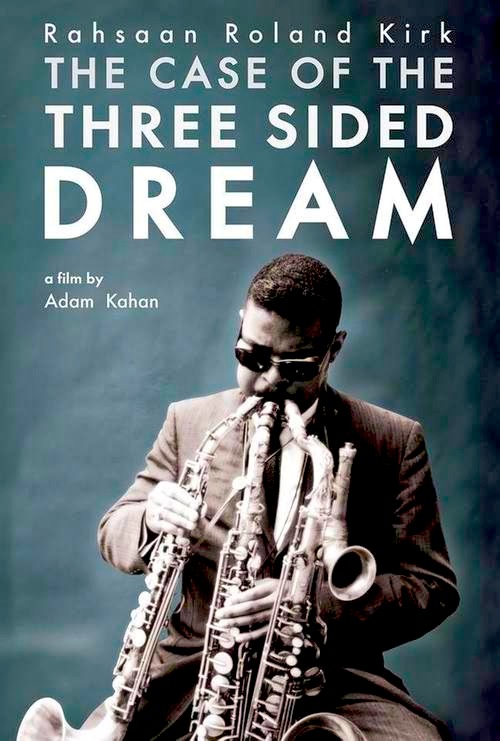The Case of the Three Sided Dream – Trailer from Adam Kahan on Vimeo.
By Joe Bendel. Even if movie fans do not know his name, they have heard his work, thanks to Quincy Jones. Rahsaan Roland Kirk’s reeds can be heard on the soundtrack for In the Heat of the Night and on Jones’ “Soul Bossa Nova,” a tune many people know as the Austin Powers theme. However, for real jazz listeners, Kirk requires no introduction. Adam Kahan pays tribute to the music and life force of the multi-reed titan in The Case of the Three Sided Dream, which screens today at SXSW.
The tenor was Kirk’s mainstay, but some of his most famous recordings feature his distinctive flute attack. He was also the preeminent stritch and manzello player, bar none. If that were not enough, he could also get incredible sounds out of clarinets, harmonicas, recorders, and sundry whistles. A true multi-instrumentalist, Kirk played any number of horns simultaneously, at a virtuoso level. Given his remarkable showmanship and an unearthly proficiency for circular breathing, Kirk was often criticized for resorting to gimmicks, but musicians like his former boss Charles Mingus knew better. To paraphrase Phil Woods, if it is just a gimmick, why don’t you try to do it? Incidentally, Kirk happened to be blind since infancy, due to a doctor’s negligence.
 In all honesty, it is probably impossible to make a dull film about Kirk, considering the power of his music and personality. Frankly, there are scores of memorable episodes in John Kruth’s biography Bright Moments that did not find their way into the film. Nonetheless, Dream is more visually ambitious than most documentaries, using animation to help convey the spirit of Kirk’s inimitable stage pronouncements, which were a show in themselves. Yet, Kahan never pursues style at the expense of his subject.
In all honesty, it is probably impossible to make a dull film about Kirk, considering the power of his music and personality. Frankly, there are scores of memorable episodes in John Kruth’s biography Bright Moments that did not find their way into the film. Nonetheless, Dream is more visually ambitious than most documentaries, using animation to help convey the spirit of Kirk’s inimitable stage pronouncements, which were a show in themselves. Yet, Kahan never pursues style at the expense of his subject.
Compared to many jazz docs, Dream features a relatively small cast of talking heads, but each one counts for a lot. Particularly notable are Kirk’s widow Dorthaan, who is a jazz institution herself through her work with WBGO (the public supported jazz radio station serving the New York-New Jersey area), and Steve Turre, Kirk’s sideman and protégé, who followed the leader’s example to become a masterful jazz soloist on the conch shells.
Of course, the music is really the thing in any doc like Dream. As adventurous as Kirk was, anyone comfortable with more soulful forms of hard bop will inhale his music like ice cream on a hot summer day. Still, Kahan’s generous clips demonstrate the difficulty in classifying Kirk under any general label. It is also rather ironic to see archival footage of Kirk’s all-star ensemble on the Ed Sullivan Show, opting for “Haitian Fight Song” instead of the producer-approved “Mon Cherie Amour,” since the propulsive Mingus standard would eventually be licensed for a Volkswagen commercial, in a slightly reworked form.
Oddly enough, Kirk’s “greatest hit” “Bright Moments” is referenced but not heard in Dream. That’s fair enough, but SXSW patrons could probably use its joyous sounds after the tragic incident late Wednesday. Regardless, Kirk’s music always has a restorative effect and Kahan presents it well. Highly recommended, The Case of the Three Sided Dream screens again today (3/15), as this year’s SXSW comes to a close.
LFM GRADE: A
Posted on March 15th, 2014 at 8:33pm.